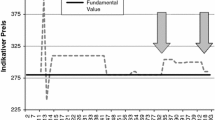Abstract
When traders have private information about a common value good, adverse selection alone is insufficient to prevent trade of the good and estimation of the common value based upon the traders’ private information. We explore sufficient conditions for nonexistence of trading mechanisms in which trade of a common good occurs, along with cases in which such mechanisms exist.
Similar content being viewed by others
Notes
The use of “ex post” here is consistent with its definition as “based on or determined by actual results, rather than expectations; calculated retrospectively” (OED Online, accessed Sept. 2021, Oxford University Press). I emphasize the phrase “actual results”: here, this means the information that the mechanism actually provides to a trader, which may be incomplete.
It is worth emphasizing that the Revelation Principle does not assert the “informational equivalence” of any equilibrium of any game with the “honest” equilibrium of a complete information direct mechanism.
Throughout this paper, the arguments of expected utility \(U_{i}(\cdot ;\cdot )\) are separated by a semi-colon, with the arguments before the semi-colon representing signals that are known by trader i at the time of the calculation and the argument after the semi-colon representing the announced signal of trader i.
The possibility results in Cramton et al. (1987, Prop. 1) and here are similar in that a partner may either buy or sell. Trading on either side of the market plays a different role, however, in these two results. Having a partner both buy and sell directly ensures incentive compatibility in (31) above. In contrast, in Cramton et al. (1987, Prop. 1), it changes the welfare of the “worst-off” type of each partner and therefore affects the potential to tax the partners and fund the deficit incurred from satisfying incentive compatibilty. This is explained in Williams (1999, sec. 2.3) and is captured by ineq. (1) in Cramton et al. (1987, p. 618). It also applies to McAfee (1992, p. 56, ineq. (10)), which studies efficient allocation in bilateral bargaining when each trader can either buy or sell.
References
Akerlof GA (1970) The market for lemons: quality uncertainty and the market mechanism. Q J Econ 84(3):488–500
Athey S, Haile PA (2007) Nonparametric approaches to auctions. In: Heckman JJ, Leamer EE (eds) Handbook of econometrics, vol 6, Part A. Elsevier/North Holland, Amsterdam, pp 3847–3965
Billingsley P (2012) Probability and measure. Wiley, Hoboken
Cramton P, Gibbons R, Klemperer P (1987) Dissolving a partnership efficiently. Econometrica 55(3):615–632
Crémer J, McLean RP (1988) Full extraction of the surplus in Bayesian and dominant strategy auctions. Econometrica 56(6):1247–1857
Holmström B, Myerson R (1983) Efficient and durable decision rules with incomplete information. Econometrica 51(6):1799–1819
McAfee RP (1992) Efficient allocation with continuous quantities. J Econ Theory 53:51–74
McAfee RP, Reny PJ (1992) Correlated information and mechanism design. Econometrica 60(2):395–421
Milgrom PR (1979) A convergence theorem for competitive bidding with differential information. Econometrica 47(3):670–688
Milgrom PR (1981) Rational expectations, information acquisition, and competitive bidding. Econometrica 49(4):921–943
Milgrom PR, Stokey N (1982) Information, trade and common knowledge. J Econ Theory 26:17–27
Milgrom PR, Weber RJ (1982) A theory of auctions and competitive bidding. Econometrica 50(5):1089–1122
Milgrom PR, Weber RJ (1985) Distributional strategies for games with incomplete information. Math Oper Res 10(4):619–632
Myerson R (1981) Optimal auction design. Math Oper Res 6(1):38–7
Myerson R, Satterthwaite MA (1983) Efficient mechanisms for bilateral trading. J Econ Theory 29:265–281
Pesendorfer W, Swinkels JM (1997) The loser’s curse and information aggregation in common value auctions. Econometrica 65(6):1247–1281
Williams SR (1999) A characterization of efficient, Bayesian incentive compatible mechanisms. Econ Theory 14(1):155–180
Williams SR, Zachariadis KE (2021) The asymptotics of price and strategy in the buyer’s bid double auction. SSRN. https://ssrn.com/abstract=2489016
Wilson R (1969) Competitive bidding with disparate information. Manag Sci 15(7):446–448
Wilson R (1977) A bidding model of perfect competition. Rev Econ Stud 44(3):511–518
Wilson R (1987) Game-theoretic analysis of trading processes. In: Bewley T (ed) Advances in economic theory, fifth world congress. Cambridge University Press, Cambridge, pp 33–70
Acknowledgements
I thank Georgy Artemov, Ivan Balbuzanov, Aaron Barkley, David Byrne, Simon Loertscher, Alex Nichifor, Kostas Zachariadis, Moritz Meyer-ter-Vehn and the referees of this paper for their comments.
Author information
Authors and Affiliations
Corresponding author
Ethics declarations
Conflict of interest
The author has no competing interests to declare that are relevant to the content of this article.
Additional information
Publisher's Note
Springer Nature remains neutral with regard to jurisdictional claims in published maps and institutional affiliations.
Rights and permissions
Springer Nature or its licensor (e.g. a society or other partner) holds exclusive rights to this article under a publishing agreement with the author(s) or other rightsholder(s); author self-archiving of the accepted manuscript version of this article is solely governed by the terms of such publishing agreement and applicable law.
About this article
Cite this article
Williams, S.R. Trade of a common value good. Rev Econ Design 27, 701–724 (2023). https://doi.org/10.1007/s10058-022-00322-6
Received:
Accepted:
Published:
Issue Date:
DOI: https://doi.org/10.1007/s10058-022-00322-6




